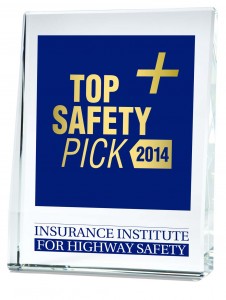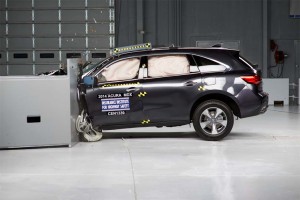The old adage that “safety doesn’t sell” certainly doesn’t apply today. It has become just as critical a factor in the buying decision for most American motorists as fuel economy.
So, there could be a lot of attention paid to the latest list of America’s safest cars, at least according to the Insurance Institute for Highway Safety. A total of 22 vehicles made the trade group’s most prestigious list, those given a Top Safety Pick+ rating, while another 17 got the still significant Top Safety Pick imprimatur.
There were a number of surprises delivered by the IIHS, however, including the absence of the new Toyota Corolla from the list. Only four products from the Japanese maker – and not a single one of its Lexus models – made this year’s safest cars list. Indeed, while there were a whopping 130 different models that made the cut for 2013, only a total of 39 are on the list this year.
On the other hand, there were eight models built by Honda and its luxury Acura brand, more than any other manufacturer.
“We’ve made it more difficult for manufacturers this year,” says Adrian Lund, president of the IIHS, which has been awarding Top Safety Picks since 2006, adding the Top Safety Pick+ category in 2012.
The latter category has proven a particularly challenging one since it requires a vehicle to perform well in the so-called small overlap test. Designed to replicate a common type of real-world crash, 25 percent of a vehicle’s front end on the driver’s side strikes a rigid barrier at 40 mph. The test reflects what happens when the front corners of two vehicles collide, or when a car clips a tree or utility pole.
Several manufacturers have done poorly in the new test, leading both the IIHS and Consumer Reports magazine to downgrade a number of Toyota products – the influential non-profit magazine lifting its Recommended Buy rating for the Camry earlier this year.
(Feds want ignition interlocks mandated after drunk driving conviction. Click Here for the story.)
The Camry did get a Top Safety Pick rating from the IIHS, but only models “built after November 2013” when the maker rushed in with changes designed to improve the vehicle’s performance in the small offset test. Similarly, only those Toyota Prius hybrids built since last month get a Top Safety Pick+ rating.
Mazda also had to tweak the design of its new Mazda3 subcompact to earn a plus rating, which only goes to models produced after October.
(Louisiana claims the dubious honor of having America’s worst drivers. Click Here to see how your state fared.”
Real-world crash statistics have shown that the latest safety technologies are responsible for a sharp reduction in traffic accidents – and fatalities – in recent years. The National Highway Traffic Safety Administration recently announced a program designed to encourage manufacturers to push even more high-tech gear into production. And the IIHS is backing that effort with its safety ratings, notably giving bonus points to manufacturers who adopt the newest forward collision warning and autobrake systems.
In fact, most of the vehicles that earned a Top Safety Pick+ rating get there only by offering some form of forward collision system – whether a basic version that sounds an alert or the more advanced versions that can bring a car to a halt if an obstacle is detected.
“Consumers who want both crash prevention technology and the latest in occupant protection have a fair number of vehicles to choose from,” Lund says. “We hope manufacturers will continue to incorporate front crash prevention, developing more robust systems and adding them to more trim levels or, better yet, making them standard equipment.”
Here’s the complete list from the IIHS for 2014:
Top Safety Pick+
Small cars
- Honda Civic 4-door
- Mazda 3
built after October 2013 - Toyota Prius
built after November 2013
Midsize moderately priced cars
- Ford Fusion
- Honda Accord 2-door
- Honda Accord 4-door
- Mazda 6
- Subaru Legacy
- Subaru Outback
Midsize luxury/near-luxury cars
- Infiniti Q50
- Lincoln MKZ
- Volvo S60
Large luxury cars
- Acura RL
- Volvo S80
Small SUVs
- Mazda CX-5
built after October 2013 - Mitsubishi Outlander
- Subaru Forester
Midsize SUV
- Toyota Highlander
Midsize luxury SUVs
- Acura MDX
- Mercedes-Benz M-Class
built after August 2013 - Volvo XC60
Minivan
- Honda Odyssey
Top Safety Pick:
Minicar
- Chevrolet Spark
Small cars
- Dodge Dart
- Ford Focus
- Honda Civic 2-door
- Hyundai Elantra
- Scion tC
- Subaru Impreza
- Subaru XV Crosstrek
Midsize moderately priced cars
- Chrysler 200 4-door
- Dodge Avenger
- Kia Optima
- Nissan Altima
- Toyota Camry
built after November 2013 - Volkswagen Passat
Midsize luxury/near-luxury car
- Acura TL
Small SUV
- Mitsubushi Outlander Sport
Midsize luxury SUV
- Volvo XC90



Crash impact worthiness has improved across the board and that is a good thing. I would not however use the current rankings as a realistic bases for a purchase as the new side impact test was never incorporated into the existing model designs and we don’t really know (yet) the validity of the new test.
Jorge,
First of all, I think you meant to say “small overlap test” and not side-impact test. Secondly, whether you would use crash-test ratings or not is irrelevant. The fact of the matter is that consumers rely (heavily, in many cases) on these tests as part of their decision-making process, as well they should given the widely varying results among manufacturers. As to validity, both the NHTSA and IIHS continue to improve their methodology and broaden the scope of their testing in order to provide consumers with meaningful information about the likelihood of survivability in varying crash conditions. There is little question, in the industry or among consumers, about the validity of these tests, and for you to assert anything to the contrary is both silly and irresponsible.
Pan,
Per my own comment, I applaud both NHTSA and the IIHS for pushing to come up with not just more stringent, but ever more valid forms of testing — by that meaning tests that reflect real world conditions. One only has to head to a body shop or junkyard to see how the new small offset, or overlap, test does, indeed, match an extremely common form of crash. You’re right…consumers do count on these. Intriguing to see IIHS push farther and faster than NHTSA. Not sure how to ascribe that: government bureaucracy, industry pressure on regulators, or what. But the new test — and the impact it has had on ratings — is significant. Seeing Toyota race to revise its cars after getting slammed for its poor overlap test performance is amazing.
Paul E.
Sorry Pan but I respectfully disagree with you. I applaud the safety efforts made so far but until we know the validity of the over-lap test it’s unreasonable to use it as the primary reason for buying a specific model.
You are certainly free to disagree but I find your opinion of my comment being “irresponsible” to be both inaccurate and inappropriate.
I am aware that many consumers base their decisions on what they read even if it isn’t necessarily accurate in the real world. Many also believe in unintended acceleration – which has never been proven to exists. Thus I would suggest being very careful about calling people irresponsible for stating their opinion of new crash testing methodologies.